Last Updated on April 25, 2024
Did you know it’s estimated that a woman will use approximately 11,400 pads throughout her lifetime? Each of these pads are disposable, which means they end up in a landfill.
Pads are typically made from plastics, cotton, wood pulp and synthetic fibers. Since some of these components are synthetic, the entire pad will not break down. That means the pad you wore when you were a teen is probably still around today, sitting in a landfill.

Some disposable pads also include artificial fragrances and synthetic chemicals into the mix, which may cause allergic reactions.
Tampons aren’t much better: During the average 40-year span that a person typically spends menstruating, an individual uses more than 9,000 tampons.
That’s why I co-founded Kayaness, a sustainable period company, with Shleby Orme, a sustainable lifestyle YouTuber who happens to be one of my best friends.
Period underwear is a reusable alternative to pads and tampons, but not all period undies are created equal.
Kayaness is committed to creating high-quality reusable items with ethical manufacturing, recycled and reclaimed materials that undergo rigorous testing for safety, and building products that are made to last.
If you’re considering switching over to period underwear but don’t know where to start, here’s a guide to period panties and how to use period underwear.

what is period underwear?
Period underwear are undergarments you wear during your menstrual cycle to take the place of disposable pads and tampons. They are constructed to look and feel like regular underwear.
Period panties have extra layers and specific fabrics that line the crotch area. This enables them to absorb menstrual blood.
Period panties can be washed and then re-wore on repeat. They are a reusable option that can be worn all throughout your period, varying from heavy to light days.
why switch to period underwear?
There are two main reasons to switch to period underwear: Reducing waste and saving money. Let’s look at each a little more in-depth.
period underwear helps the environment
It’s estimated menstruating women will go through more than 11,000 pads in their lifetimes. Disposable period pads may contain up to 90% plastic, which means when they’re discarded and sent to a landfill, they take hundreds of years to break down into tiny pieces, aka microplastics.
Period products also have excessive plastic packaging: A 12 pack of pads is wrapped in plastic film, and each pad is individually wrapped in plastic (for sanitary purposes). Plastic film cannot be recycled via curbside recycling in most areas.
Additionally, pads are made in factories, which are often powered by fossil fuels. It takes a lot of energy to transform raw materials like cotton and crude oil into useable products. Not to mention both conventional cotton and plastic have negative impacts on the environment.
Conventional cotton, not organic cotton, is frequently used in most period products. It is a water-hungry plant and heavily sprayed with pesticides that can pollute groundwater.
Each of these materials has their own carbon footprint individually (you can learn more about cotton’s carbon footprint here). But plastic must be transformed from crude oil into moldable plastic which takes up a lot of energy, water and resources.
A year’s worth of disposable pads and tampons for one person produces 8.9kg of CO2 emissions, the same as charging a mobile phone more than 1000 times.
That’s why Kayaness period panties are made from organic cotton and recycled polyester. This, paired with the fact they’re reusable, dramatically cuts down on their carbon footprint.

period underwear save money
Using disposables adds up over time. Let’s assume a person menstruates for 40 years and buys a $8 pack of disposable pads every month (excluding tax). That adds up to $3,840 over a lifetime, $96 a year.
This is likely an underestimate as the cost of menstrual pads, the taxes, and frequency of purchase can vary. For example, if you have a heavy flow, you may find yourself purchasing two packs instead of one per month.
That said, let’s look and see how much period panties will save you. Upfront, period underwear will cost more: For 5 pairs of Kayaness’ high waist briefs, it would cost $160 without tax.
However, if you use and take care of them for 2 years, that’s $192 saved based on the prior example above. At that point, the period underwear would’ve already paid for themselves and then some.
If you use them for five years, that’s $480 saved: Think of all the matcha lattes that could go towards instead!

how to use period underwear: a simple step-by-step break down
If you’re interested in trying out period panties but feel intimidated, here’s how to use them. Hint: It’s really simple!
- Order your period panties (we’ll talk about finding the right fit for you below).
- Wash them before your first wear. This can be in the washing machine (done on delicate) or handwashing, but always let it air dry. More instructions on how to wash your period panties are given below.
- When your period starts, just slip on your period underwear like normal panties. Depending on your flow, you can wear these for several hours. You may even be able to wear them all day, if your period is light enough. However, you should make it a point to change after 24 hours into a fresh pair.
- Change into a fresh pair of period undies and remove/clean the soiled ones. Repeat this process until your period is over!
how to wash period underwear
To clean your period underwear, there are a few steps you must take:
- After you remove your period underwear, soak or rinse them in cold water. Do this until the water runs clear.
- If using a washing machine, wash them on a delicate or gentle cycle with a mild detergent. To make your underwear last, consider handwashing in the sink.
- Don’t put them in the dryer, let them air dry by laying the underwear flat or hang drying them. You can even improvise and use coat hangers to hang them up to dry.
finding the right fit
At Kayaness, we offer two styles of period underwear: High waisted briefs and boyshorts. Both these styles provide ample coverage, all while prioritizing comfort. We also offer sizing from XS to 4XL, so there’s something for everyone.

faqs
do you wear a pad with period underwear?
You don’t have to wear a pad with period underwear, unless you want to. It also depends on your flow: If you’re a heavy bleeder, you may prefer a little extra protection.
However, Kayaness underwear offers heavy absorbency and can hold up to 3-4 regular tampons worth of flow. This will last for hours.
Can you use period panties for postpartum bleeding?
Yes, you can use period underwear for postpartum bleeding. However, during the beginning of it, you may want to pair them with pads for fuller coverage.
Can you swim in period panties?
There are specific period swimwear brands out there for this purpose. Generally speaking, a reusable menstrual cup or organic tampon is recommended for swimming on your period.
how often should you change your period underwear?
On average days, it’s good to change your period underwear at least once every 8-12 hours. However, it will entirely depend on your flow: If you have a heavy flow, you may need to change your pads more frequently.
how many pairs of period underwear do you need?
How many pairs of period underwear you need will depend on your unique flow.
If you’re new to period underwear, consider investing in at least two pairs to wear on your average-to-lighter days. This will let you try them out and get a feel for what works for your body.
You could also use period underwear only at night to have comfortable, fuller coverage.
If you’re committed to fully transitioning to period underwear, having about 8-10 pairs of period undies should be enough.
So, will you be making the switch to period underwear? Let me know in the comments!
The post How to Use Period Underwear: The Ultimate Guide to Period Panties appeared first on Going Zero Waste.
How to Use Period Underwear: The Ultimate Guide to Period Panties
Green Living
How Toad&Co’s Clothes Help Everyone Enjoy the Outdoors
This is a sponsored article about a brand that was independently assessed by our rigorous ratings system. We’re proud to only collaborate with “Good” and “Great” rated brands. Learn more.
US brand Toad&Co has a socially and environmentally responsible approach to clothing, creating pieces inspired by the outdoors and with a lower impact on the environment. Not to mention an enduring commitment to helping everyone get outdoors through its work with non-profits. Read on to discover the brand’s environment-first ethos.
Focusing on what matters most
“We make feel-good clothes for positive impact—fostering community around doing good, enjoying life’s simple pleasures, and embracing the unexpected,” says Sarah Palladino, director of people and impact at Toad&Co as she introduces the Californian brand. This “simple pleasures” concept applies to Toad&Co’s approach to design, too, and prioritises quality and responsibility over trend-led items. This, in turn, means the brand focuses its energy on clothes that are comfy and practical enough for everything from work to outdoor exploring, and on maintaining its ongoing commitments to using lower-impact materials, partnering with cleaner factories, and looking for new ways to do more with less.
Since day one, it’s been about more than just clothes. From choosing sustainable practices in every corner of our business to supporting programs that protect the planet and make the outdoors more accessible to everyone—knowing we stand for more is what keeps us going
Gordon Seabury – CEO at Toad&Co
Lower-impact materials and producer responsibility
Opting for lower impact materials is one of the core ways brands can address their impact on the planet: “Sustainable materials make a world of difference,” Toad&Co says. “We use organic cotton, recycled fibres, and other high-quality materials known for low-impact growing and cleaner manufacturing.”
The brand’s selection of more sustainable materials includes organic cotton, hemp, TENCEL Lyocell, and recycled fabrics like wool, cotton, and polyester. It also looks to third party clothing certifications like bluesign®, OEKO-TEX® STANDARD 100, and Global Organic Textile Standard, and it publishes its list of restricted substances for all to see.
Toad&Co also operates a resale platform, called ToadAgain, online and at its IRL store in Maine, US, to keep its clothes in the loop.
Supporting non-profits and access to the outdoors
Toad&Co donates 1% of its profits to organisations working to empower others and, in particular, enable better access to the outdoors for all.
In 1996, Toad&Co partnered with Search, Inc. to co-found the Planet Access Company, a full-functioning warehouse that trained and employed up to 70 adults with disabilities annually.
Determined not to stop at the front door, the brand also co-founded Search for Adventure in 2004, a unique travel program to facilitate vacations for adults with disabilities. Over 20 years later, the social venture partnership has evolved—and includes a flagship store in Chicago, a program called Visibility Arts that nurtures creativity through sharing Search, Inc. artist’s work, neurodiversity and disability awareness training, and an expanded Search for Adventure program. In 2024, the brand supported 147 nights of camping for adults with disabilities through the program.
We give back to—and partner with—organisations that align with our three pillars of giving: conservation for human enjoyment, equity and accessibility, and do the right thing
Sarah Palladino – director of people and impact at Toad&Co
One of Toad&Co’s key partnerships is with Brave Trails, which is dedicated to LGBTQ+ youth leadership, to support it in putting on accredited camps, mentorship programs, and meet-ups for LGBTQ+ youth.
Shop favourites from Toad&Co’s new collection
Read on to discover some of the standout items that balance style with practicality from Toad&Co’s lineup.
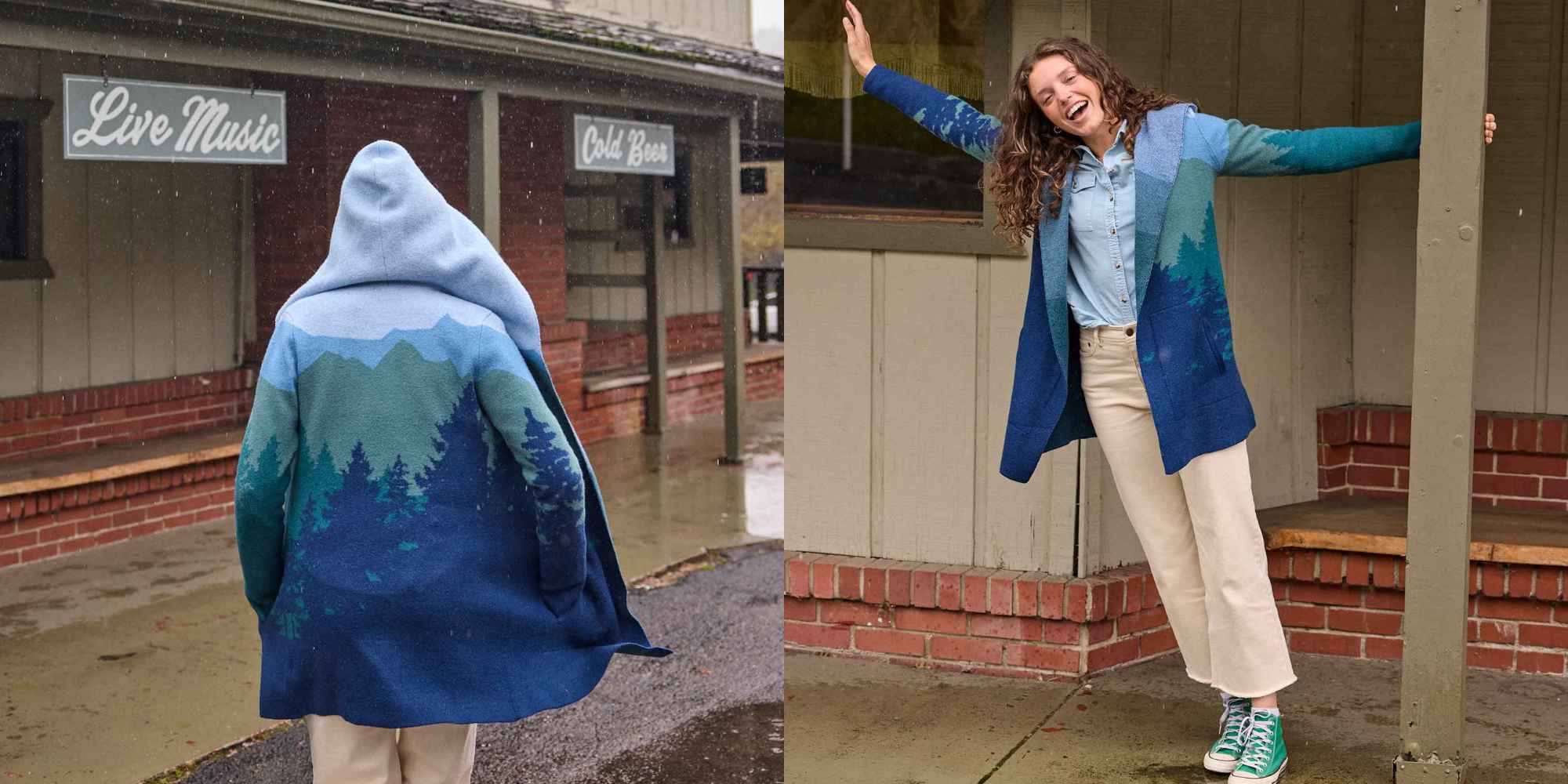
Woven with a beautiful alpine jacquard pattern, this hoodie is made from non-mulesed Merino wool and features pockets at the sides. It’s ideal as a mid-layer under a longer coat when you’re out exploring, or as a cosy item for grabbing a post-walk hot chocolate.
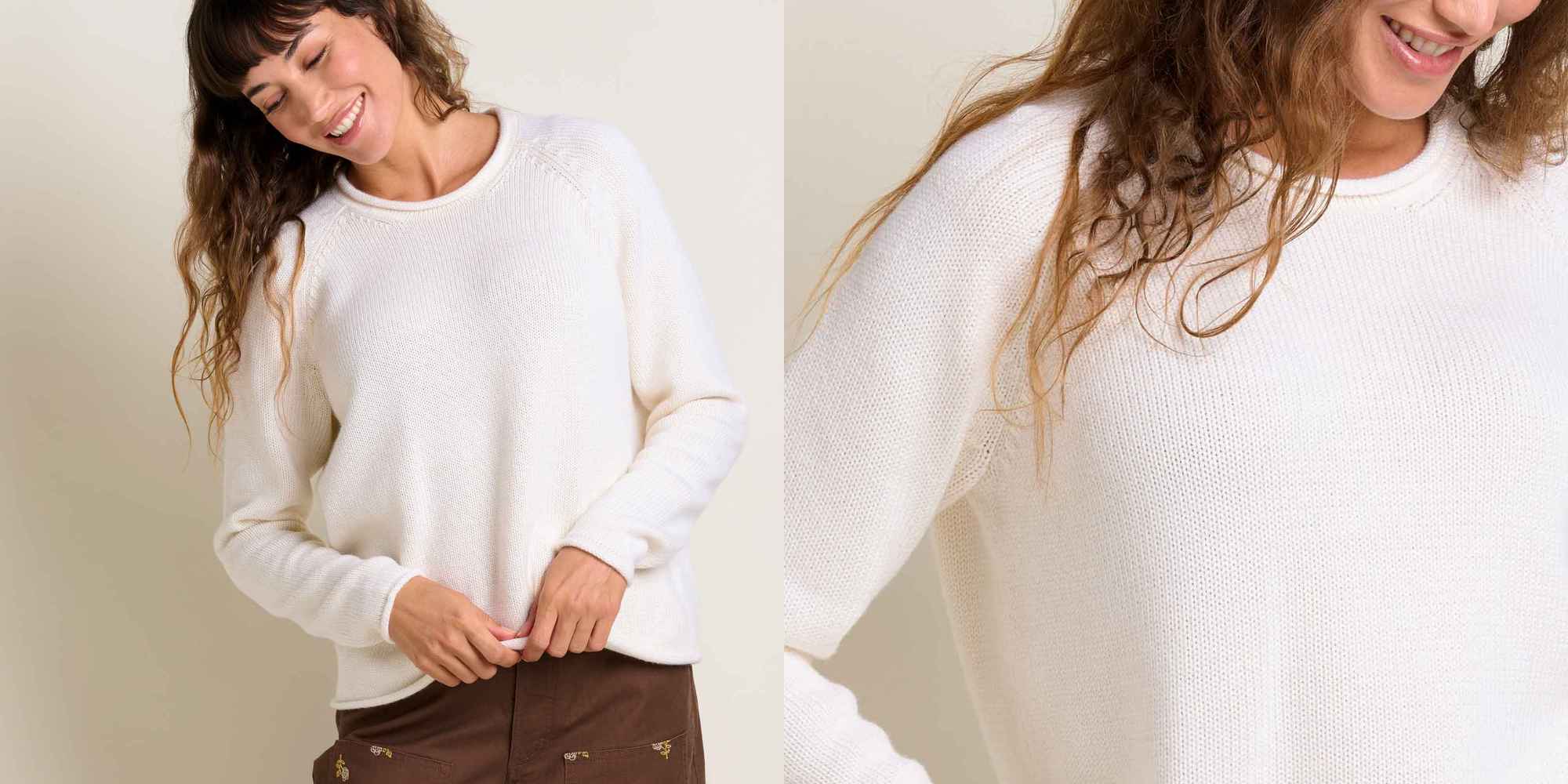
This Alpineglo sweater is a blend of 50% organic cotton and 50% non-mulesed Merino wool, so it’s going to help regulate your temperature in most climates. On top of that, the neutral tone and straight fit make it really versatile—you’ll be reaching for it on the regular.
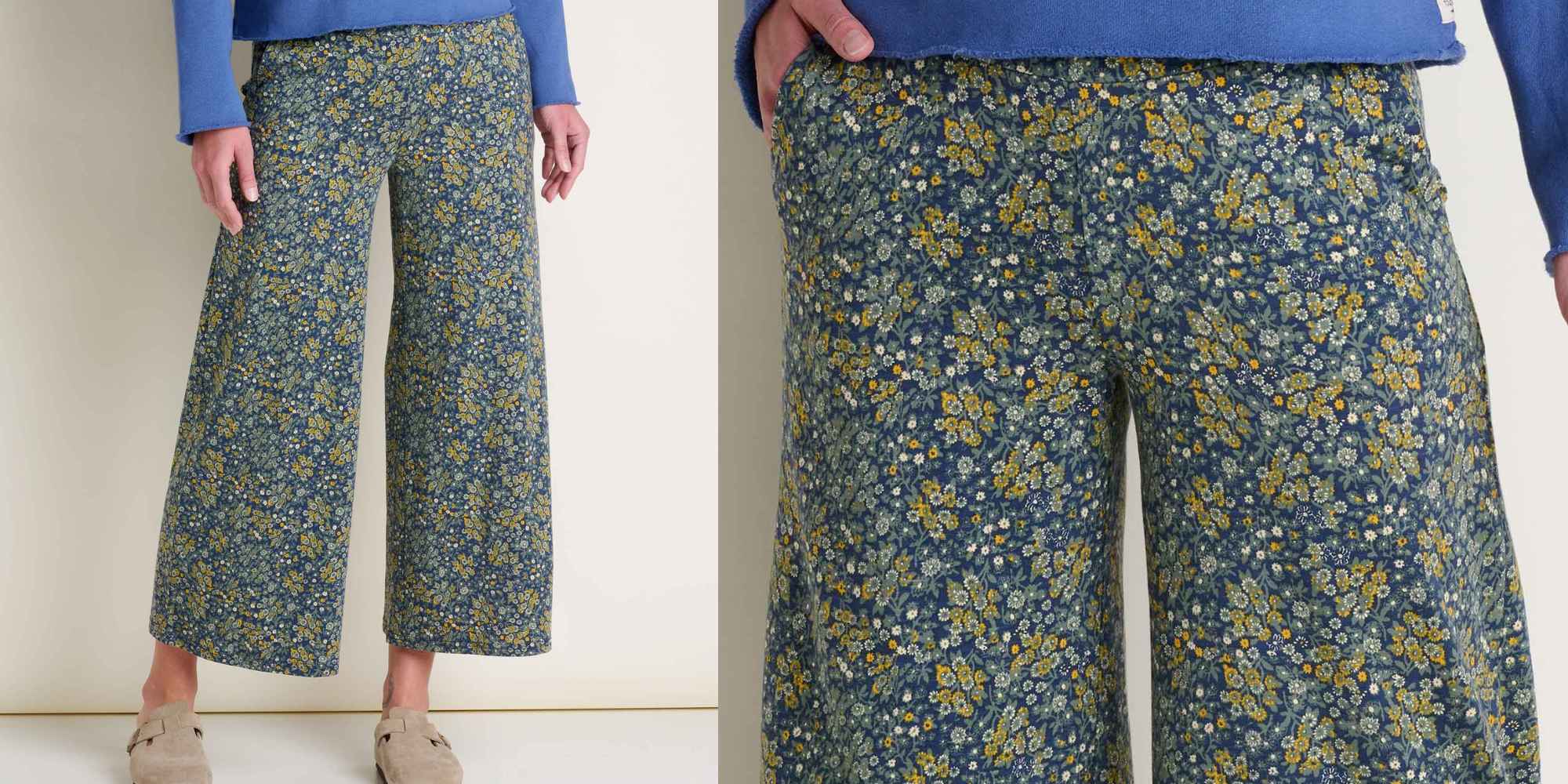
Toad&Co calls these cropped trousers “sweatpant comfortable, going-out presentable”, which makes sense, given they’re made with organic cotton and Tencel Lyocell for softness and have a comfortable wide waistband, not to mention a pretty floral pattern.
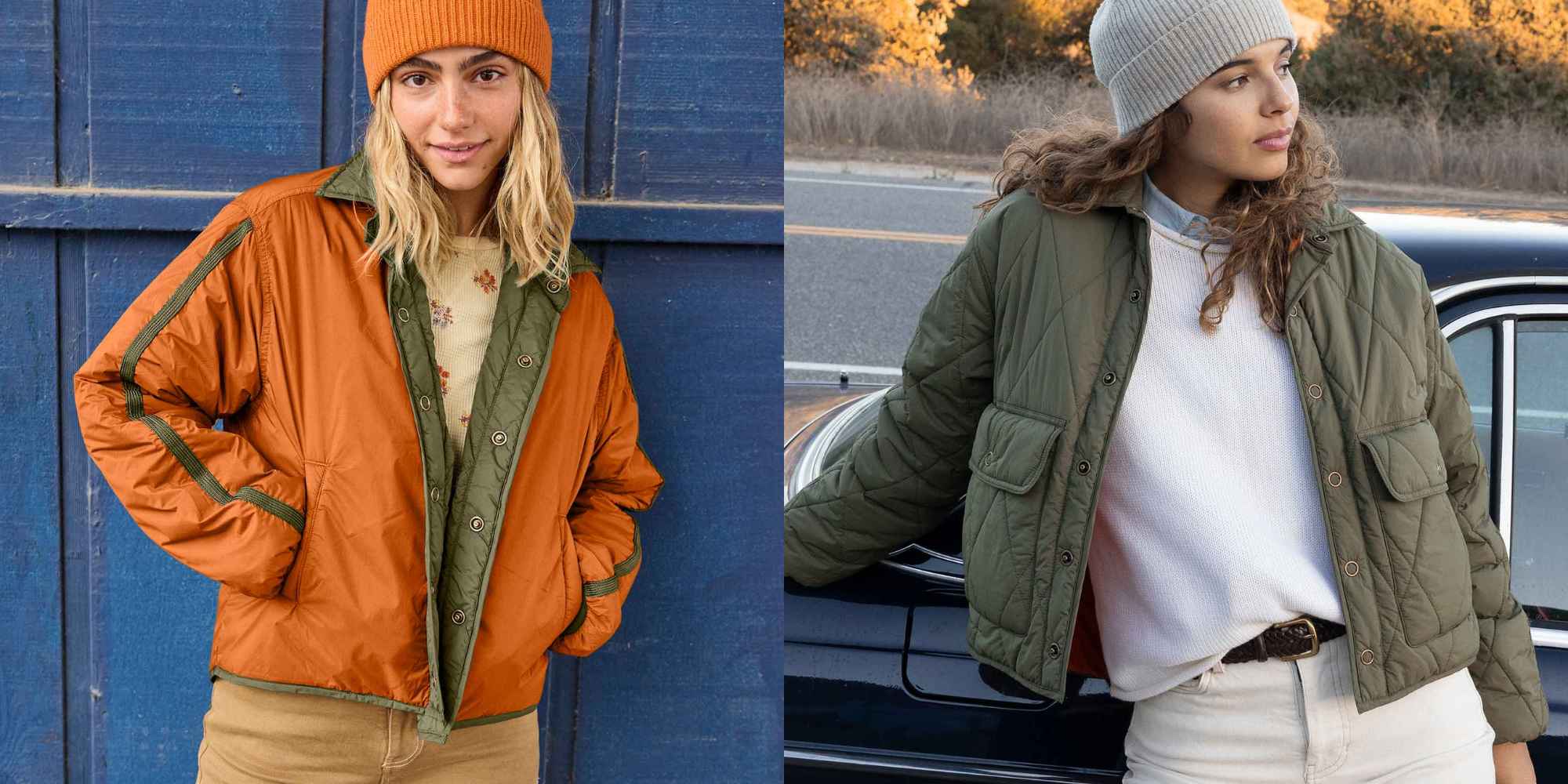
This Nomader jacket is reversible, packable, and water-resistant. In other words, it’s the ideal item to take with you for outdoor adventures. It’s made from recycled nylon and lightly quilted for warmth.
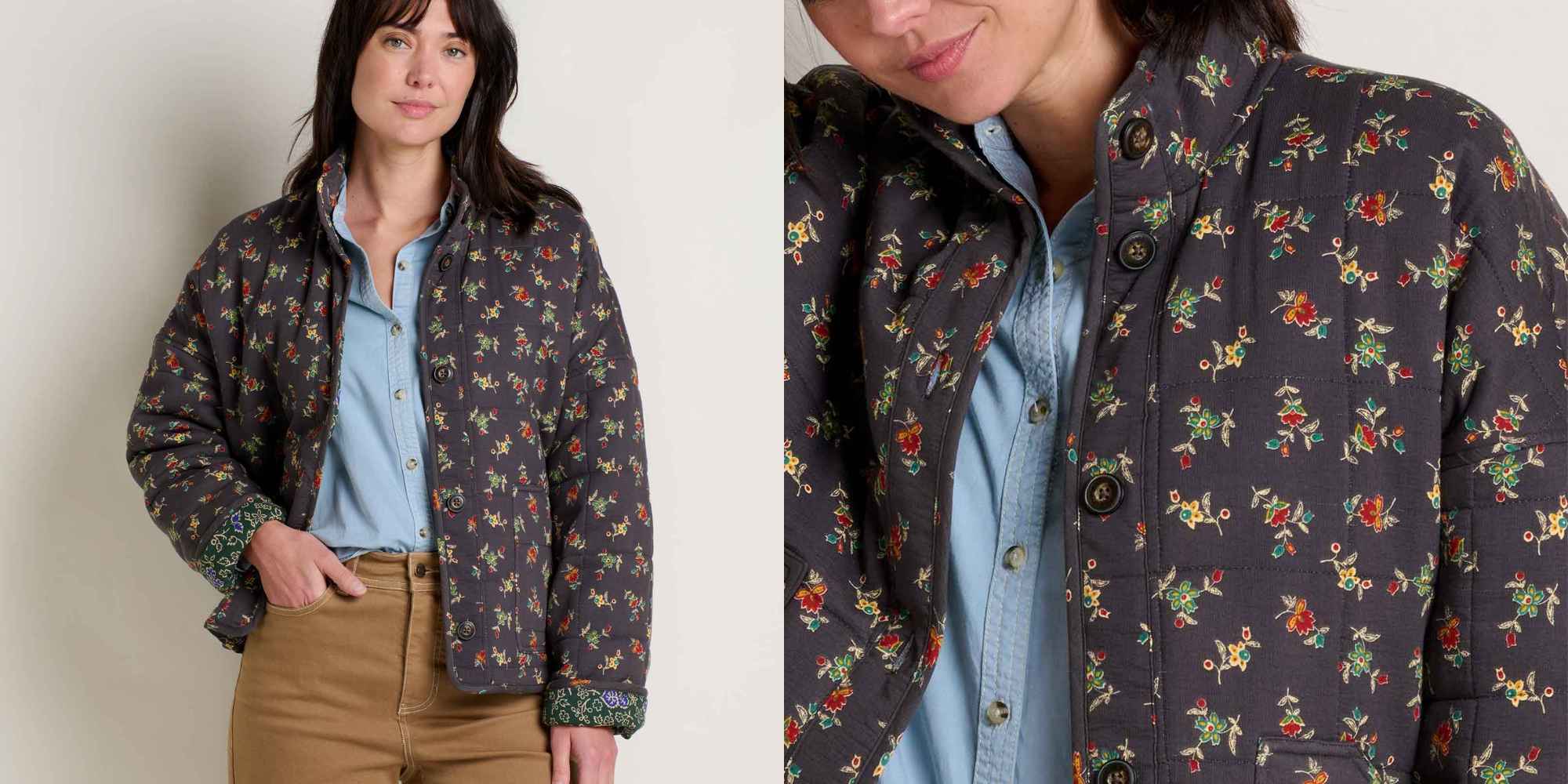
Toad&Co picked the crepe-like organic cotton for this jacket so that you could fold it away in a bag and have it still look presentable when you pull it out. It’s also packed with recycled polyester padding for extra warmth.
 Balsam Cutoff TrousersThese Balsam Trousers are made with a tiny bit of stretch and a special waistband for comfort, so they’ll flex with you and feel good all the time. The neutral brown colour also goes with so many options.
Balsam Cutoff TrousersThese Balsam Trousers are made with a tiny bit of stretch and a special waistband for comfort, so they’ll flex with you and feel good all the time. The neutral brown colour also goes with so many options.These Balsam Trousers are made with a tiny bit of stretch and a special waistband for comfort, so they’ll flex with you and feel good all the time. The neutral brown colour also goes with so many options.
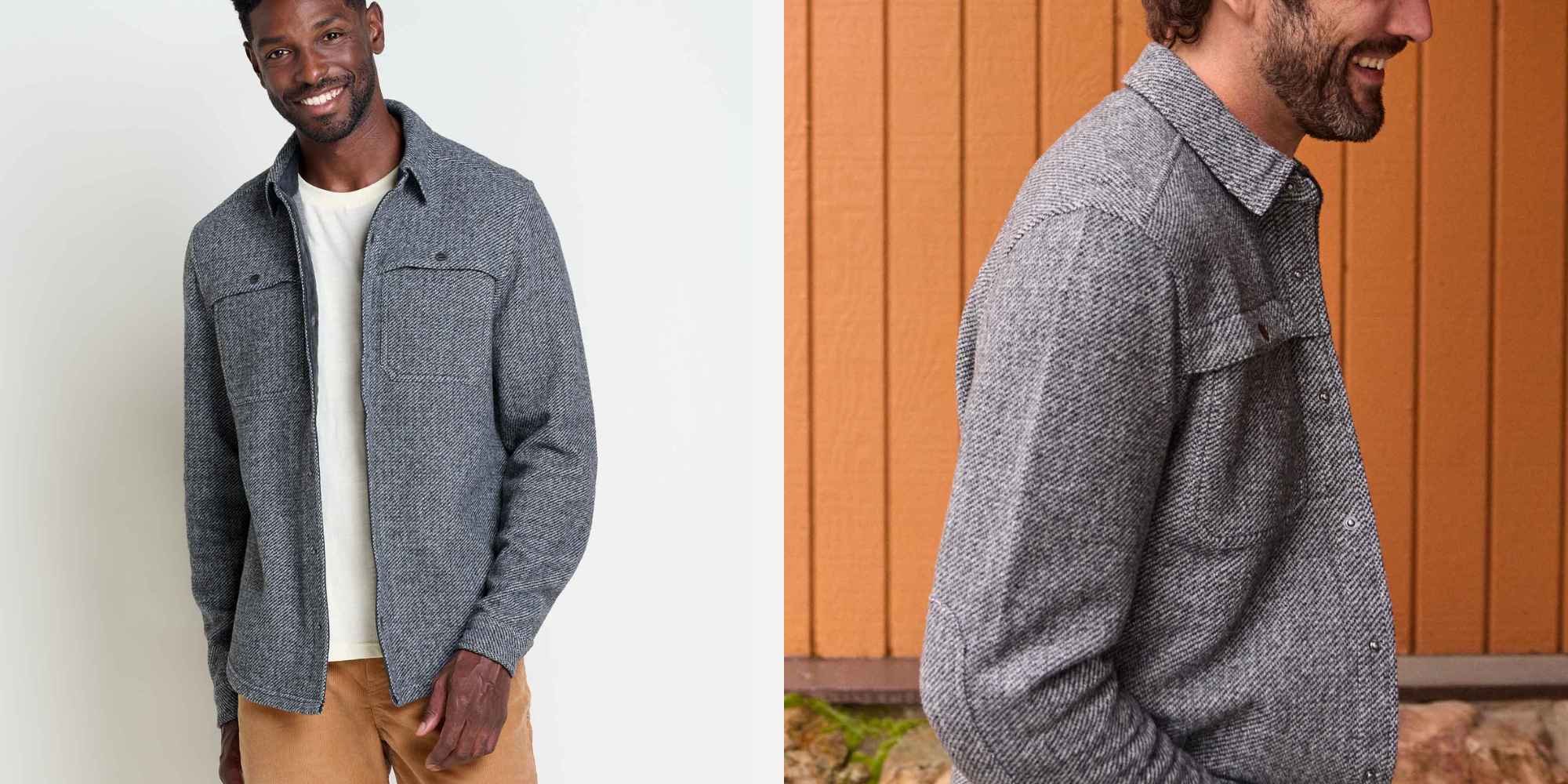
Going from a walk to dinner? From the office to drinks? This Kennicott shirt jacket fits the bill for all of the above. The smart twill fabric incorporates recycled Italian wool.

This is Toad&Co’s Re-Form Herringbone: a blend of recycled cotton and polyester that offers a soft drape and an attractive herringbone weave that looks smarter than the average checked shirt.
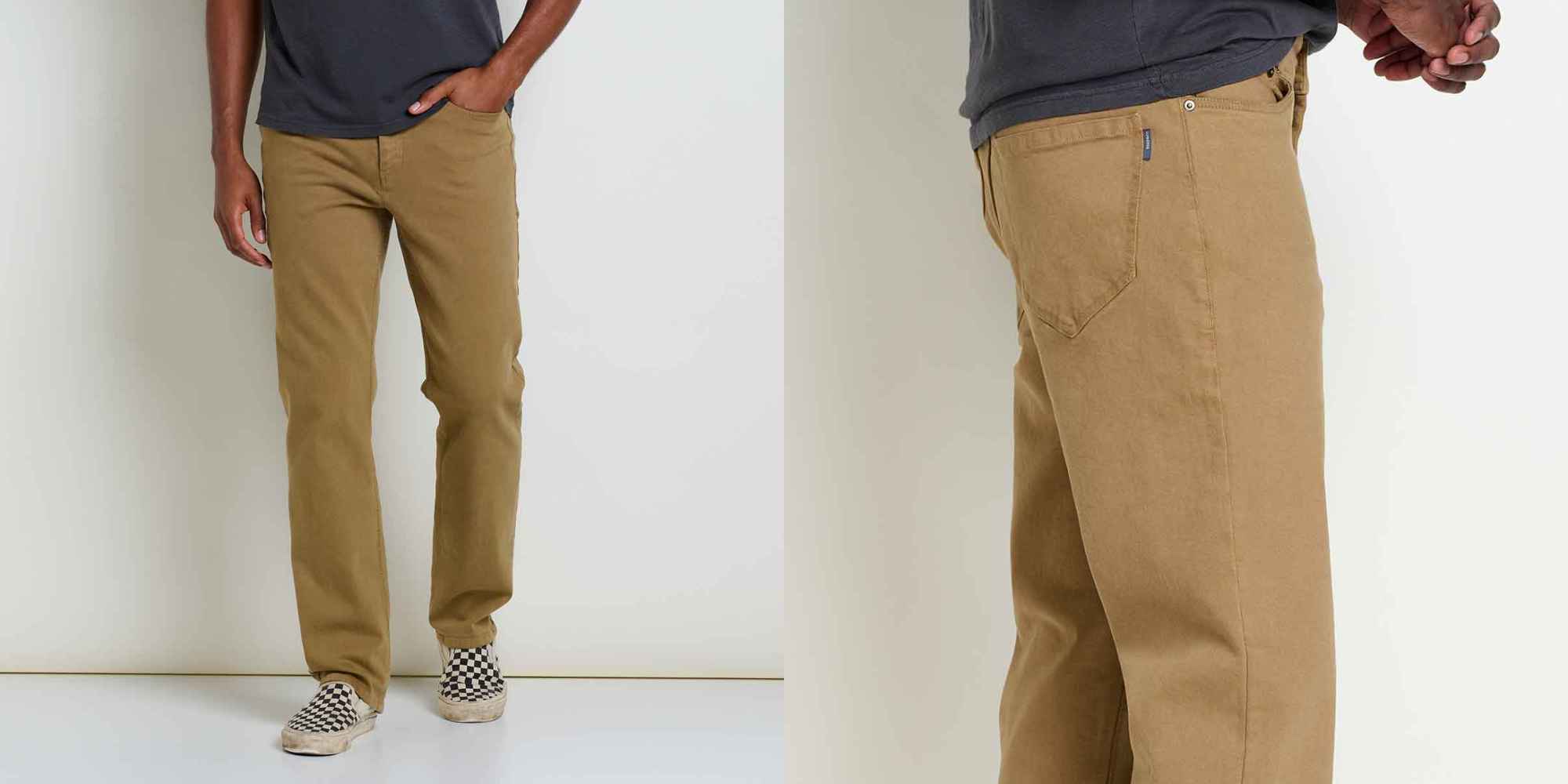
Like the women’s equivalent, these Balsam trousers have a touch of stretch and a comfortable ‘FlexForm’ waistband that mean they’re going to feel comfortable from the get-go—and you won’t need to worry about a belt, either.
Discover more of Toad&Co’s clothes.
The post How Toad&Co’s Clothes Help Everyone Enjoy the Outdoors appeared first on Good On You.
Green Living
50 DIY Christmas Presents Anyone Can Make
Last Updated on November 21, 2025
If you’re on the handmade Christmas kick this year, you’re not alone. So am I!
I’m choosing presence over presents this year and bringing back the 90s Christmas I loved as a kid – simple, crafty, low pressure, and full of small moments that feel meaningful.

If you want to gift thoughtfully, and without breaking the bank, these DIY Christmas presents are for you. There’s something for everyone on this list – whether you prefer easy or complex DIYs.
I’ve included all kinds of DIYs – beauty, cooking, fashion, and practical gifts alike. Best of all? Many of these tutorials are zero waste (or close to it).
what are good homemade Christmas gifts?
Good homemade Christmas gifts include consumable items, like homemade nut butters, vanilla extract, or jams. But not all homemade gifts are edible – you can also make items like bath bombs, candles, body scrubs, beeswax wraps, and so much more.
If you’re extra crafty, you could even make wooden gifts (like shelving or tablet holders), ceramic items (like mugs or jewelry), or knitted/crocheted pieces (like blankets, scarves or hats).
It all depends on your level of skill, time at your disposal, and ingredients/materials you have access to.
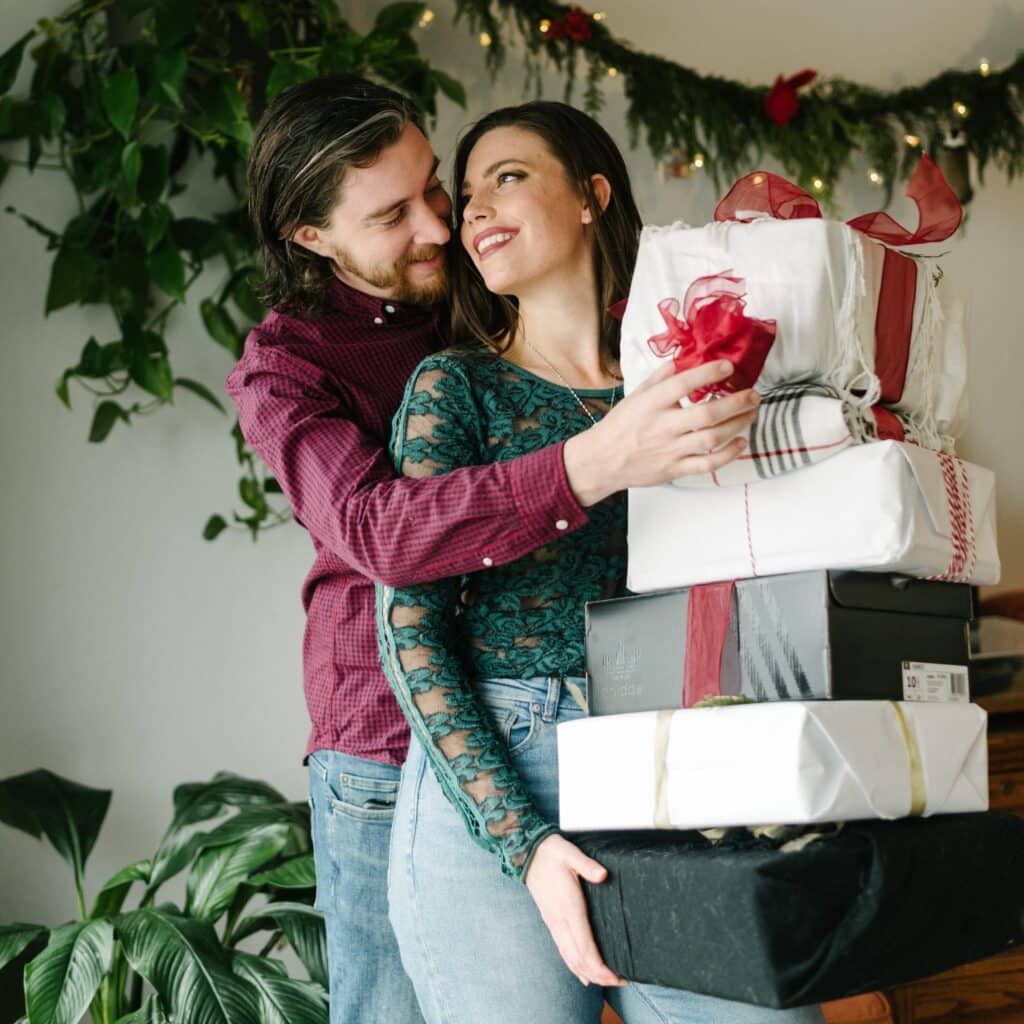
what are good inexpensive Christmas gifts?
Some good inexpensive Christmas gifts are DIY cornstarch ornaments, handmade body or lip scrub, seasoned salt blends, and homemade treats (like these chocolate chip cookies or vegan sugar cookies).
And never forget to hit up your local thrift store – you can find so many great items that would make affordable gift baskets!
Wrapping DIY Christmas gifts also doesn’t have to be expensive. Reusing gift bags and ribbons from last year, upcycling packaging paper, or even repurposing a scarf for furoshiki wrap are all low-waste and affordable!
RELATED: Gift Wrapping: How to Keep It Easy, Eco and Chic
how can I make a last minute gift?
You can make a last minute gift by getting crafty using the materials you have on hand!
For example, if you have a cardboard box, why not try making an upcycled cardboard dollhouse, vehicle, or pirate ship for a child? For adults, a DIY storage container or a shoe rack works.
One of my fav last minute gifts is scented bath salts in an upcycled glass jar – just a little Epsom salt and essential oil blends will do the trick!
Here’s my list of DIY Christmas gifts – something for everyone and every skill level.

- Bath salts
- DIY makeup like mascara/eyeliner, or lip to cheek
- Bath bombs
- Lip scrub
- Lip balm
- Face mask
- Body lotion
- Natural perfume
- Dry shampoo
- Shampoo bar
- Body soap
- Deodorant
- Rose water toner
- Hand-poured coconut/soy/beeswax candles
- Simmer pot in a jar
- Cookie, brownie, soup mix or hot cocoa mix in a jar
- Handmade seasoning blends
- Vanilla extract
- Vegan caramels or plant-based butter wrapped in compostable parchment paper
- Herb or citrus infused olive oil
- Peanut butter + jam
- Beeswax wraps
- Apple or pumpkin butter
- Sourdough or no-knead artisan bread
- Finished embroidery hoops
- Embroidered pillows, tote bags, clothes or cloth napkins
- Sewn cotton rounds
- Knitted scarf, hat, gloves, sweater, or blanket
- Hand warmers
- Quilt blanet, quilted coat or quilted wallet
- Tie dyed secondhand silk scarves, clothing or sheets
- Hand painted or drawn artwork
- Air dry clay paint palette
- DIY wooden frame for paintings or print photos
- Handmade ceramics (mugs, chawan, chasen holder, vase, spoon rest, etc.)
- Woodworked items (birdhouse, shelving, bookcase, wall guitar mount)
- Carving wooden bowls by hand
- Natural branch coasters
- Plant propagations in one of these DIY planters
- Seed balls using native seeds
- Handwoven baskets or bowls
- Macrame produce bag
- Macrame plant hanger
- Fabric paper mache bowls
- Upcycled paper earring jewelry
- Clay earrings
- Handmade plush toys
- Felt ‘food’ toys
- Wooden toys (like vehicles, blocks, or dollhouses)
- Knit or crocheted baby clothes
What do you think of these DIY Christmas presents? Let me know in the comments!
The post 50 DIY Christmas Presents Anyone Can Make appeared first on Going Zero Waste.
Green Living
8 Best Non Toxic Rugs For a Sustainable Home
Last Updated on November 6, 2025
Did you know most rugs are made from polyester, aka plastic? Arguably, a good chunk of our furniture and home decor is nowadays.
And lets not forget – rugs can get a lot of foot traffic. If it’s made from polyester, chances are those plastic fibers are going to shed and get onto us. Or worse, in us.

Some of the links in this post are affiliate links; for more information please see my disclosure policy.
Microplastics have been found in human feces, blood, and even placentas. And according to a study from Stanford University, those who had microplastics in their plaque had a higher risk of heart attack, stroke and death than those who didn’t.
On top of this, 5 billion pounds of rugs go to waste each year – that’s 2% of total US landfill. And if they’re made from plastic? They won’t biodegrade.
It’s more important than ever to reduce our exposure to microfibers where we can. Which is why I’ve rounded up the best non toxic rugs on the market.
what is the least toxic rug?
The least toxic rug will have sustainable materials and use no harsh chemicals (like PFAs) in their production.
Here’s what to look for when purchasing a non-toxic rug:
- Sustainable materials, such as organic cotton, jute, sisal or wool
- Low-waste packaging + delivery
- Natural, non-synthetic dyes
- Third-party certifications like OEKO-TEK, Fair Trade, GOTs
- Easy to spot-clean or machine wash
- Available in various styles, patterns + colors to suit your needs
do all rugs have PFAS?
According to Department of Toxic Substances Control (DTSC), only four samples of 201 carpets and rugs were found to contain more than 100 parts per million in their fibers, indicating PFAS were intentionally added to the products.
However, while PFAs may not be a huge concern for rugs, microplastic pollution is, specifically if your carpet is synthetic. Your best bet is to check the material your rug is made from and choose natural fibers whenever possible.
what is the best non-toxic rug for nursery?
The best non-toxic rug for a nursery would be made from natural materials like wool and organic cotton (which are soft on baby’s skin).
I recommend also checking for natural latex for the rug backing and underlay pads. Brands on this list that offer kid-friendly sizes and patterns include Lorena Canals, Nestig, Quince, and Loomy (more on each below).
what brand of rugs are non-toxic?
The brands of rugs that are non-toxic are listed below. I’ve gone ahead and highlighted some of my favorite features of each brand, but it isn’t an exhaustive list. Be sure to check out their websites for more information.

1. hook and loom
- Various rug sizes, shapes + patterns
- Made from GOTs certified organic cotton, recycled cotton + wool
- No dyes or harmful chemicals
- No latex
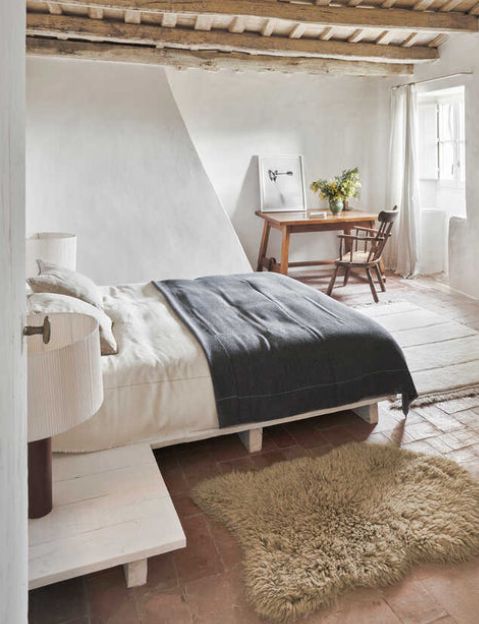
2. lorena canals
- Various rug sizes, shapes + patterns
- Handmade by artisans using recycled materials like organic cotton + wool
- Nontoxic dyes
- Make your own option
- Machine washable
- Rugcycled line made from recycled materials in their own factory
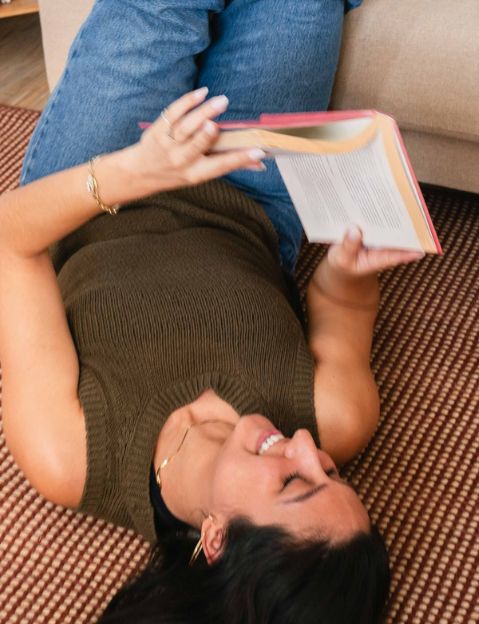
3. sabai
- Field rug
- Woven using wool + jute
- Available in 3 varying sizes
- Rug pad add-on available for reduced movement
- Certified B Corporation

4. quince
- Various sizes + patterns, best known for vintage-inspired looks
- Made from natural materials like wool, jute, + cotton
- Handcrafted by artisans in India
- Transparent pricing practices
- Compostable poly bags + recycled plastic mailers

5. west elm
- Rugs for every area of the home, in varying sizes
- Made from wool, jute, hemp, cotton, TENCEL + recycled materials
- Handspun by skilled artisans in India
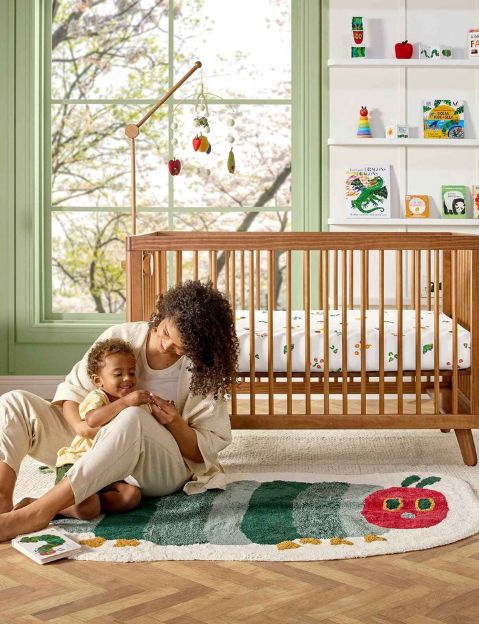
6. nestig
- Area + washable rugs made with fun shapes/designs for babies + kids
- Washable rugs made with organic cotton + nontoxic dyes
- Area rugs made with cotton + each colored element crafted from recycled cotton
- Handmade in Brazil

7. cold picnic
- Various rug shapes + sizes, abstract patterns + bold colors
- Made with wool, bamboo silk, cotton, hemp, + deadstock materials
- Designed in a Brooklyn studio, handmade by artisans in India
- Committed to reducing packaging waste where possible
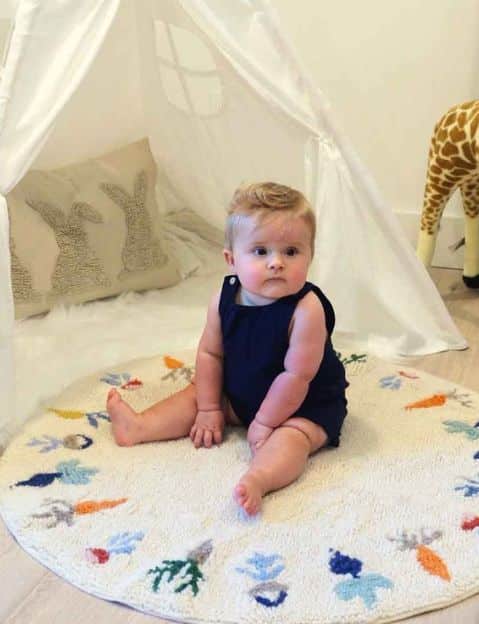
8. loomy
- Various rug sizes, shapes + patterns
- Made from banana silk, hemp, jute, recycled fiber, viscose, or wool
- Any colored yarn dyed using low-impact techniques
- Handcrafted by indigenous artisans
So what do you think of these non toxic, sustainable rugs? Let me know in the comments!
The post 8 Best Non Toxic Rugs For a Sustainable Home appeared first on Going Zero Waste.
-
Climate Change4 months ago
Guest post: Why China is still building new coal – and when it might stop
-
Greenhouse Gases4 months ago
Guest post: Why China is still building new coal – and when it might stop
-
Climate Change2 years ago
Spanish-language misinformation on renewable energy spreads online, report shows
-

 Greenhouse Gases2 years ago
Greenhouse Gases2 years ago嘉宾来稿:满足中国增长的用电需求 光伏加储能“比新建煤电更实惠”
-
Climate Change Videos2 years ago
The toxic gas flares fuelling Nigeria’s climate change – BBC News
-

 Climate Change2 years ago
Climate Change2 years ago嘉宾来稿:满足中国增长的用电需求 光伏加储能“比新建煤电更实惠”
-

 Carbon Footprint2 years ago
Carbon Footprint2 years agoUS SEC’s Climate Disclosure Rules Spur Renewed Interest in Carbon Credits
-
Climate Change2 years ago
Why airlines are perfect targets for anti-greenwashing legal action



